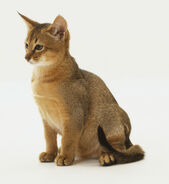| This page uses Creative Commons Licensed content from Wikipedia (view authors). |
| Abyssinian | ||
|---|---|---|
 | ||
| Information | ||
| Origin |
Egypt, Abbysinia | |
| Breed Standard | ||
| AACE | ||
| Cat (Felis catus) | ||
| List of Cat Breeds | ||
The Abyssinian is a slender and wild-appearing breed of cat that originated in Egypt. Abyssinians are rather slender and are usually very colorful.
Appearance[]
The Abyssinian is very slender, almost like the runway model of the cat world. These slender beauties and usually have a spring in their step while they prance about their territory. Abyssinian cats' eyes are almond-shaped and usually come in a large variety of colors such as green, yellow, and gold.
The cats' short-haired coats usually come in four four colors: red, ruddy, blue, and fawn. Each color has a different set of ticking, or bands of color, on the individual hairs.
Personality[]
Abyssinian cats are usually extremely intelligent. Sometimes, they are even too smart for their own good. They need a lot of attention in order to make sure they do not accidentally knock something over or cause much trouble. They aren't much of lap cats, but they are affectionate and really try to snuggle with their owners.
Lifestyle[]
Their long, slender, powerful body was most definitely not meant to stand still. Abyssinians are very active and eager to explore, especially high places that would seem out of reach for normal cats.
Abyssinians are perfect for the owner who loves to play with their lively cat. One thing, however, is not a good match for an Abyssinian cat: a knick-knack collection.
Grooming[]
Abyssinians are low-maintenance cats who will simply lick for long hours. There is no real reason to bathe them; however, an occasional brushing is recommended.
Coat types[]
The coat is medium-length, dense, and silky to the touch. The Abyssinian, and a similar long-hair breed called the Somali, have coats that are unusual enough to catch attention. These felines owe their special coat to one dominant mutant gene known as Ta. Each hair has a base color with three or four darker-colored bands; the hair is the lighter colour at the root, and the darker "ticking" color at the tip. This ticking is found only in the Somali, Abyssinian and Singapura.
The first cat to have its entire genome published was an Abyssinian named Cinnamon. The original Abyssinian coat colour is known as 'Usual' in the United Kingdom and as 'Ruddy' elsewhere. The coat has a warm reddish-brown base, with black ticking. The feet and the backs of the hind legs are always black.
Over the years, various other colours have been developed from this original form, but the markings on the coat have remained the same. The back of the hind legs and the pads of the paws are always darker than the rest of the coat.
A popular colour is Sorrel, which has a cinnamon (yellowish-brown) base, with chocolate brown ticking, paw pads and backs of the legs. Blue Abyssinians, which have become increasingly popular in recent years, have a light beige base colour with blue ticking, paw pads and backs of the legs.
The relatively rare Fawn Abyssinians have a light-cream base colour, with darker cream ticking and warm dark cream pads and backs of the legs. A six-month old Chocolate Abyssinian (left) with his Sorrel father
Silver Abyssinians are a separate group among the breed. Although this colour has been in existence for decades, it is not recognised by the Cat Fanciers' Association, the world's largest registry of pedigreed cats. In Silvers, the undercoat is always a pure silvery white. The markings include black, blue, warm dark cream and cinnamon. Purely Silver Abyssinians are difficult to breed because they sometimes have undesirable tan patches in the coat. In addition to this, any spots in the coat show up more clearly on a silver coat.
Rare colours include the tortoiseshell, red, cream, chocolate and lLilac, which are all bred on a small scale in The Netherlands and the United Kingdom.
Abyssinian kittens are born with dark coats that gradually lighten as they mature. It usually takes several months for the final coat colour to be established.
Temperament[]
Abyssinians are extroverted, extremely active, playful, willful and intelligent. They are usually not "lap cats", being too preoccupied with exploring and playing.
They do not meow often and usually will not stand being picked up. They are popular among breeders and owners, and can be very successful show cats. Not all Abyssinians are shown, however, because the color and type standards are very exacting, and because some are shy towards strangers and timid in public. They have quiet, engaging voices.
"Abys", as they are affectionately referred to by their fans, need a great deal of interaction with the family to keep them happy and can get depressed without daily activity and attention.
They generally get along well with other cats, although they need their space and the females can sometimes be irritable around other cats. Abyssinians are known for their curiosity and enjoy exploring their surroundings, including heights. They are sensible cats that do not take unnecessary risks.
As one might expect from such an intelligent and physically capable breed, Abyssinians are known to be formidable hunters. They adore toys and can play for hours with a favorite ball. Some play fetch.
History[]
The name 'Abyssinian' refers to Ethiopia, but most of the stories about the origins of Abyssinians refer to Egypt. Genetic research suggests the breed originated near the coast of the Indian Ocean, where colonists may have purchased animals from wild animal traders. The breed was developed in Egypt.
The breed is sometimes believed to have originated from one Egyptian female kitten named Zula, who was taken from a port in Alexandria by a British soldier and brought to England in 1868. This theory is not established because there is no solid link between Zula and the cat first listed as an Abyssinian in 1882.
Many sources repeat the story that the Abyssinian breed is a few thousand years old and comes from Ancient Egypt, as the cats resemble those in ancient paintings. Ancient Egyptians made sculptures of them. There are also stories that wild 'Abyssinians' live in parts of North Africa today.

